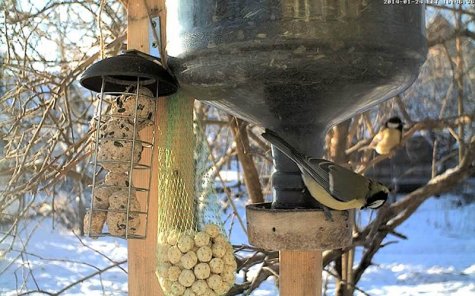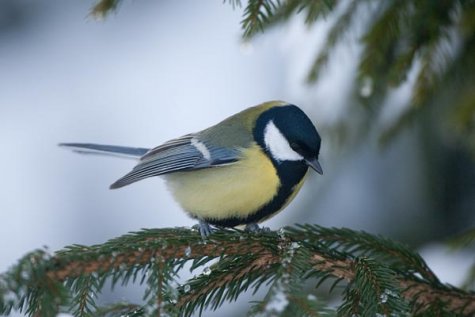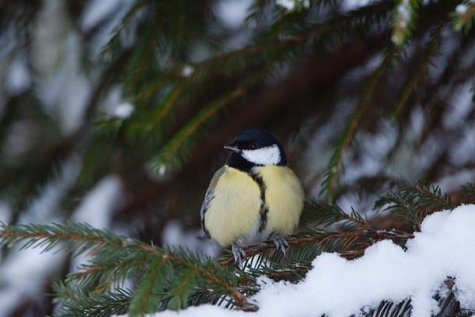Winter bird feeder cam – Great tits
Web camera image Molly, LK forum
Translation: Liis
Seed snatching queue …
Great tit Rasvatihane Parus major
In our childhood memories the tit with the yellow belly is probably one of the first birds to remain permanently in our memory – certainly in those homes where fathers or grandfathers had crafted a bird feeding house to feed the birds with sunflower seeds and unsalted lard in winter.
Great tits gather near human settlements for the real winter and there are reasons for it. For an overnight spot some crevice in a cornice, a balcony corner, a woodpile in places with firewood heating, or a nestbox can be found; there are enough places where to find shelter and you will be closer to the food too. Moreover cities are couple of degrees warmer too. Great tits haven’t developed the instinct or habit to save winter stores but they are extremely skilled at finding the seeds hidden by other birds and other tits in tree bark crevices.
In the morning twilight the first visitor at the birdfeeder is an older male bird who has spent the night nearby; sometimes the bird in action isn’t even visible in the darkness, only heard. Of all our tit species, among those who visit birdfeeders and forest tits, the great tits are the biggest: length up to 15 centimetres and weight around 20 grams.
Photos: Arne Ader
Great tit
Great tit
The gleaming white cheeks next to the bluish-black head plumage of the great tit catch attention, and the black band on the yellow breast. A clear white streak on the blue-grey wings, tail likewise blue-gray. Back plumage greenish-yellow and of course a yellow patch at the nape – quite colourful creatures by the description.
Is it possible to distinguish between the similar-looking great tits? Yes, but the characteristics below are not unqualified rules.
Adult males are characterised by the broader black tie on the chest that widens even more on the belly. The head plumage seems glossier and their behaviour at the birdfeeder is dominant.
The belly stripe of females and young birds is clearly narrower and leaves an uneven impression. All great tits have a black beak and bluish-grey legs.
In camera view we see some thirty individuals in action; the birdfeeder is visited in order of importance: the places of dominant individuals are in branches of trees or shrubs closer to the feeding place. Occasionally the tit flock flies away, for instance when pigeons “attack” the feeder, to investigate what happens elsewhere in Otepää or what better is on offer in other feeding places. They move about in flocks that are often joined by other passerines too – but note that they keep a reasonable distance between themselves because with someone who presses too close even brawling can break out. The winter numbers are certainly more than half a million birds, but the winter garden bird count will give a clearer picture of this years numbers.
In the next few months a number of changes will take place in the behaviour of great tits – we will let you know.











